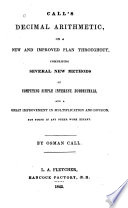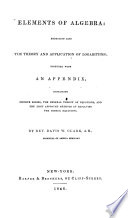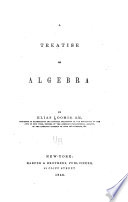 | Nicolas Pike - Algebra - 1808 - 470 pages
...and the greatest term, to Jind the turn of the seriet. RULE. — 1. Divide the greatest term by such power of the ratio, •whose index is equal to the number of terms less 1 -. take the quotient from the last term, and make the remainder a dividend. 2. Djvide the dividend... | |
 | Nicolas Pike - Arithmetic - 1832 - 544 pages
...1th term is 2X0 ! , ai.d the 8th term would be 2X27, nnd so on. In an asvending series, therefore, multiply the first term by that power of the ratio whose index is one less, than the number of the term sought, anil the product is the term sought. In a descending... | |
 | Frederick Emerson - Arithmetic - 1834 - 300 pages
...term and the ratio being given, to find any other proposed terra. RULE. Raise the ratio to a power, whose index is equal to the number of terms preceding the required term: then, if it be an increasing series, multiply the first term by this power of the ratio; but, if it... | |
 | Mathematics - 1836 - 488 pages
...less one. When the first term and number of terms are given, the last term is found by multiplying the first term by that power of the ratio whose index is one less than the number of terms. Alligation is a general name given to the mixing of simple things... | |
 | Frederick Emerson - Arithmetic - 1839 - 300 pages
...term and the ratio being given, to find any other proposed term. RULE. Raise the ratio to a power, whose index is equal to the number of terms preceding the required term: then, if it be an increasing series, multiply the first term by this power of the ratio; but, if it... | |
 | Osman Call - Arithmetic - 1842 - 200 pages
...fourth tetm is 2X23; and the eighth term would be 2X27,and soon. In an ascending series, therefore, multiply the first term by that power of the ratio, whose index is one less than the number of the term sought, and the product is the term sought. In a descending series,... | |
 | Davis Wasgatt Clark - 1844 - 394 pages
...multiplied by the number of terms less one ; the sum will be the logarithm of the last term. C EXAMPLE. 1. The first term of a geometrical series is 4, the ratio 5, and the number of terms 61. Required the last term. Or, log. /= log. 4+(log. 5) x 60=0.60205999... | |
 | Almon Ticknor - Arithmetic - 1846 - 276 pages
...x22, the 4th term is 2x23, and the 8th term would be 2 X27, &c. In an ascending series, therefore, multiply the first term by that power of the ratio whose index is one less than the number of the term sought, as mentioned above, and the product is the term sought.... | |
 | Davis Wasgatt Clark - Algebra - 1846 - 374 pages
...multiplied by the number pf terms less one ; the sum will be the logarithm of the last term. EXAMPLE. 1. The first term of a geometrical series is 4, the ratio 5, and the number of terms 61. Required the last term. Or, log. 1= log. 4+(log.5)x 60=0.60205999+41.... | |
 | Elias Loomis - Algebra - 1846 - 380 pages
...the series, we obtain That is, The. last term of a geometrical progression is equal to the product if the first term by that power of the ratio whose index is one less than the number of terms. (242.) To find the sum of all the terms. If we take any geometrical... | |
| |